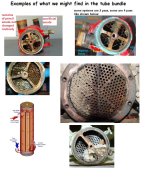I have low seawater output at the exhaust. I've used Barnacle buster in thru the raw water pump but no luck. Does the raw water circulate thru the heat exchanger from the pump as well?
Yes, the seawater first enters the Heat Exchanger's tube bundle. (seawater inside of the tubes..... coolant on the outside of the tubes)
Within the tube bundle, it removes engine heat from the coolant.
With a "Full System", the coolant also removes heat from the exhaust manifolds.
With a "Half System", the coolant removes engine heat only.
In either scenario, the seawater then goes on to and out of the exhaust system.
Exhaust Elbows are always seawater cooled!
Within the Elbows, you will have a small port where the "spent" seawater will be introduced into the exhaust flow.
These ports must be clear and fully open as to NOT restrict flow.
Input from the r/w pump is low as well using my flush bucket. It looks like the raw water pump is not sucking in water very fast even with a new impeller. Do I need to flush the heat exchanger from a different area?
Let's start with what style and model seawater pump you have!
Is it belt driven?
Is it a crankshaft mount style?
Is the impeller depth correct for the pump body's depth? (a correct impeller will sit proud by approx .010")
NOTE: the smallest suction breach will prevent any seawater pump from working correctly.
In other words, from the pump back to the seawater intake area, there can be NO suction breach!
To test for a suction breach, your best option is to put the system under negative pressure (i.e., vacuum) ..... not pressure.
As you apply vacuum to the system (shop vac for example), you can use shave cream on the suspect areas.
The shave cream will disappear at any area of breach.
Side note:
One or both ends of the H/E should be equipped with a removable cover or plate or rubber cap component.
Remove it, and you will see the interior of the tube bundle (the seawater side).
A rod (of the correct OD and length) can be pushed through each tube as to clear it of any corrosive build up.
Basically, this is the equivalent of removing bugs and debris from your car/truck radiator.


